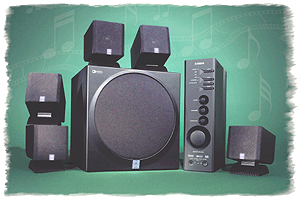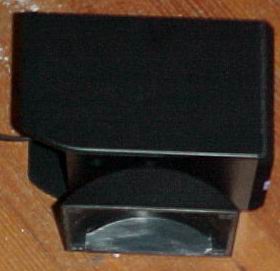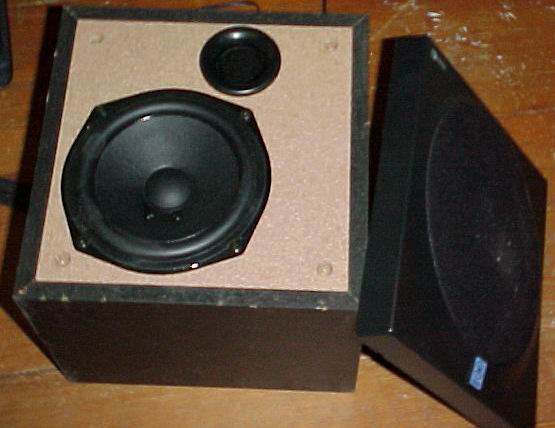
Original Link: https://www.anandtech.com/show/763
Yamaha TSS-1 Dolby Digital / DTS 5.1 Surround Speakers
by Jim Warren on May 7, 2001 1:44 AM EST- Posted in
- Smartphones
- Mobile
 Introduction
Introduction
As digital surround sound technologies trickle down to computer based home theatre systems, the technology is first available to those willing to pay for the latest and greatest. With some added engineering, carefully chosen compromises, revised approaches, or just sheer volume, the technologies can be brought to wider audiences at lower prices. Dolby Digital has seen this process; it is now followed by DTS technology.
Yamaha has recently released its TSS-1 surround sound system. While offering it as an affordable solution, it is accompanied by an impressive interface section, including both Dolby Digital and DTS decoding capability. Also, the unit serves as a receiver in some respects since it can select from multiple inputs - optical and coaxial SPDIF as well as a four channel analog connection.
On the acoustic side of the system, there are five satellites, each with two-inch drivers, accompanied by a five-inch woofer in the sub unit. The sub also uses Yamaha's "Active Servo Technology" in an effort to increase bass output. The entire package is offered in both black and white finishes, as denoted by a B or W on the model number, respectively.
Specifications (courtesy of Yamaha):
|
Output Power |
48W Total Power (6W per satellite x 5, 18W for subwoofer) |
|
Frequency Response |
40Hz - 20 kHz |
|
Input Sensitivity |
200mV (1kHz, 4 ohms at rated power) |
|
Drivers |
2" cone for satellites, 5" driver for subwoofer |
|
Speaker Modes |
5.1 channel full scale; 4.1 channel surround; stereo |
|
Inputs |
2" Digital inputs (1 optical, 1 coaxial); 2 analog inputs |
|
Controls |
Master volume, individual levels for center speaker, effects speakers, subwoofer; full-mute |
|
Box Dimensions |
16" (W) x 16" (H) x15" (D) |
|
Box Weight |
20.9 lbs. |
Setup
Out of the box, the TSS-1 comes almost completely assembled. A few minutes with a screw driver is necessary for completing the process, though far less assembly is necessary than an average toy for a six year old. The package consists of five satellite speakers, the amplifier unit and stand, the subwoofer unit, and a couple of audio cables. Over half of the system is prewired, cutting down on the number of connections.
Once the pieces are unpacked, placement decisions must be made. The amplifier/decoder unit is designed to stand vertically on the desktop, after attaching its base with the enclosed screws. As all of the controls for the system are on the front of this unit, it is not very viable to place it under a desk. The important thing to keep in mind during placement of the unit is that all of the speaker and audio cables will run to this unit, which can get a little cluttered.
The satellites are the next units to be placed. The recommended speaker placement information included in the manual offers no new insights that are specific to these speakers. However, there is a lovely diagram to reinforce the common sense of symmetry in placement in case any questions arise.
The layout for satellites remains consistent with a standard 5.1 surround system. Place the front satellites so that while sitting at the computer, the user will be centered between them. Then place the center satellite on top of or below the visual source, which should be centered between the front speakers. Finally, the rear surrounds will again be placed symmetrically about the user.

 Each
satellite includes a desktop stand for adjusting the height of the sound field.
Preassembled out of the box, they default to level (no angle). Adjusting the
angle on the speakers will raise the sound field to where the listener needs
it - ear level. Unfortunately, the stands aren't well marked for making even
adjustments on both sides, which can make creating an even sound field difficult.
Adjustments do require a screwdriver. For the center speaker, the stand can
be completely removed so that the unit may be placed on top of a monitor or
TV. For this setup, there is also a piece of double sided Velcro for attaching
the speaker more securely. Also included are rubber feet for the desktop stands.
Each
satellite includes a desktop stand for adjusting the height of the sound field.
Preassembled out of the box, they default to level (no angle). Adjusting the
angle on the speakers will raise the sound field to where the listener needs
it - ear level. Unfortunately, the stands aren't well marked for making even
adjustments on both sides, which can make creating an even sound field difficult.
Adjustments do require a screwdriver. For the center speaker, the stand can
be completely removed so that the unit may be placed on top of a monitor or
TV. For this setup, there is also a piece of double sided Velcro for attaching
the speaker more securely. Also included are rubber feet for the desktop stands.
The satellites come prewired with speaker cable. The front and center unit all have 3 meter cables, while the rear speakers offer 7 meter wires. The cables are sufficient for installing the system in a small to medium sized room, depending on how the wires are run. As they are hardwired into the speakers and are also terminated in RCA cables, it is more difficult to substitute longer cabling in the system. The speaker wire is rather small gauge, but the system is not high powered, so this is acceptable.
The subwoofer consists of a cubic enclosure that is on the smaller side. It will tuck away under a desk quite easily. Like the satellites, it is prewired with speaker cable that simply needs to be run back to the amplifier unit.

Once the speaker system has been assembled, the connection to the computer is the next step. The TSS-1 offers a number of connection options that make it very versatile. For digital sources, there are both optical and coaxial SPDIF connections, with the appropriate cables included in the box. In addition, for standard analog playback, there are minijack connections for both front and rear speakers, to allow for four channel playback - something that is overlooked entirely too often when designing a computer surround system that may be used with four channel output soundcards. Included are two minijack cables for connecting to most soundcards. The one cord not included with the system is any sort of minijack to RCA adapter that can be used to tap into the digital interface found on many soundcards; we provided our own to complete the connections. One nice feature is that the different inputs are individually selectable, so the unit is more of a receiver that can work with multiple sources, or in the case of digital versus analog playback, multiple audio formats.

The final connection is for power. The unit uses an external AC to DC converter, which is designed in the power brick style. This means the converter is wired in line with the main connection as opposed to being either internal or built into the plug (wall wart). This design doesn't take up extra space on the wall outlet or a power strip. Once this last connection is made, the unit can be powered up, and the audio performance examined.
The Sound
The amplifier unit for the system is the first step when checking for the sound of the system. On the front of the unit is a test button that runs a pink noise sequence to check the five satellites for correct wiring and operation, but can also be used to set each speaker to equal volume levels to compensate for different distances to the listener.
The best thing to listen to a system with first is a favorite audio track or DVD scene. A little bit of an open mind is required to tune the system, checking both software and hardware settings that could be adjusted to make the system sound right. The initial objective is to balance the system between sounding good, and sounding correct. Though these may appear to be the same, it is important that the sound system be pleasurable to listen to (the good part), while also not altering the character of the original track (accuracy).
For this purpose, there are level controls for the center channel, the surround volume, and the subwoofer built into the amplifier system. Unfortunately, there are no tone controls on the TSS-1, but keep in mind that your soundcard may offer some software controls in its audio control panel. Do a little exploring, as they may be hidden under an advanced options panel that requires a little digging. Oftentimes, the equalization ends up only being able to adjust the levels of the highs and lows, though some cards offer a little more control.

The first test of the system indicated that it was going to require some tweaking. Out of the box, the highs were extremely emphasized and the bass got carried away. Adjustments to the highs in software brought things a little more under control, though there is a strong high frequency presence in the system.
Many computer speakers systems are plagued by a frequency response characterized by excessive highs and mismatched low mid frequencies. This arises from the sub/satellite design when designers try to use the sub for more than what it should.
The small drivers utilized in satellites speakers do no have the mass or the size to move the necessary air volume to recreate lower midrange and upper bass frequencies. As a result, the satellites can't get down to the lower musical frequencies and especially low vocals. Many computer speaker systems are designed with a high crossover frequency in an attempt to compensate for this situation by sending the low mid frequencies to the subwoofer.

Unfortunately, this “solution” creates a two-fold problem. The first difficulty is that large drivers designed to produce actual “sub” ranges are designed to move lots of air in order to impart the necessary energy. This design is not optimized for lower mid frequencies, which also require more accuracy. Subwoofer systems are also designed on the concept of the lack of directionality for bass frequencies. However, this only applies to frequencies below 100 Hz, far below the crossover points of most of these systems. The result is that half of the program seems to come from the sub while half of it originates in the satellite. Combine this with the roll off in the lower mids, and the systems are characterized by displaced and overemphasized highs and lows.
Yamaha's approach to conquering the challenge of size, efficiency, and tonal quality comes from their Active Servo Technology. Based on the description in their technology brief, it seems like they have basically assigned a product name to a ported enclosure. They also address the resistance inherent in the cone of the speaker, though it sounds like the system is just trying to overcompensate for the bass in a smaller driver. The system is described as turning the water up in a restricted water hose - basically, if it's not loud enough, turn it up.

Unfortunately, applying the technology to the subwoofer seems counterproductive and actually overemphasizes the separation between subs and satellites. Though there is strong volume from the cabinet, the base is extremely washed out, with little to no accuracy or punch. Combine this with the lack of lower mids, and the bottom end of the system is disappointing.
The surround sound performance of the systems is on par with what the certifications indicate. It accurately decoded both DTS and Dolby Digital info, automatically selecting the format based on the digital stream provided.
The inputs on the system are worth playing around a little with. The digital input has three different types of decoding - DTS, Dolby Digital, and normal stereo decoding. Each selection has its own sonic characteristic, as there is either different circuitry or a different algorithm implemented in each case. The final comparison for the inputs is also provided by the front and rear analog inputs.

In ranking the digital inputs, the comparison is based on listening to demo CDs designed to bring out the accuracy of the respective technologies, but the final analysis is based on the sonic quality of the program as processed by the input. What that means is that although different program material was played for the tests, it was program material designed to make each input sound its respective best. Then, a judgment of how the acoustics of the TSS-1 system affected the program was made.
The results of the comparison were that on this system, the DTS digital input and processing sounded the best, followed by Dolby Digital. In the grand scheme of things, both of these exceeded the analog sound quality (not judging based on surround sound, just program quality). The stereo digital input trailed well behind the analog input— it sounds hollow and concentrated on the highs of the program.
For normal music operation and gaming, the analog input provided a warm input with low noise levels. The system seems to have a low noise floor, as there is little to no hiss in the system, even at high volumes.
The system is definitely designed for smaller format environments as it lacks the power to get very loud. As the volume control goes up, the highs distort first as they were overemphasized in the first place. The bass response also gets left behind as the volume goes up and the highs take over. Don't try to knock plaster down with the system, because it won't even come close.
With the system thoroughly tested, it was time to step back from the system and examine the whole package. See how it shakes out in the conclusion.
 Conclusion
Conclusion
Yamaha's TSS-1 system targets the upper midrange computer speaker buyer looking for a budget system. Intending to bring DTS decoding to a sub $300 system, they are stacking up against the surround sound gaming systems more and more prevalent these days. Some features were unique while others were absent. The sonic quality of the system, combined with its features, leads to a value estimate and general impression.
The system is designed to bridge the gap between computer based home theatre and computer gaming by offering a number of connectivity options. For DVD playback, a variety of digital inputs and decoding schemes are available. At the same time, analog connections can be made and independently selected for 4 point gaming playback. The flexibility of the system is a strong point - it will work on the desktop or with a smaller entertainment system if there is a desire to move away from the computer.
Beyond the input selection, there is a limited control interface for the system. Other than system volume, only the relative levels of the surround, center, and subwoofer channel can be adjusted. Any other adjustments must be made prior to the signal reaching the speaker system. In addition, there is no remote control as seen in other comparably priced systems—the system design requires the unit to be in arms reach, and most likely on the desktop.
Acoustically, the system is somewhat lacking. The washed out bass is the most plaguing sonic problem. The unit tries for lots of bass energy, though lacks the clarity necessary to accentuate the program; instead, the room is filled with sub undertones that are unwanted. The stereo digital input was also surprisingly disappointing in its response, to the extent that it's not very feasible to use for a listening environment.
The sub/satellite design common to computer systems has issues again in this system. Neither the satellites nor sub can handle lower mid frequencies extremely well, getting left behind in the program material somewhat. While steps were made to increase the quality of the input options with DTS, the acoustics aren't necessarily there to support the decision.
For individuals looking to run the system exclusively as a surround sound playback system, the system stands as an economical option. Sacrifices have been made in sonic quality and features to get the price down, but the DTS and Dolby Digital compatibility is there. For normal music playback, the analog interface to the system should be used over its stereo digital input.
For gamers, the system is not going to have the bass response necessary to keep explosions well pronounced. The washed out bass will overpower the soundfield. The surround sound capability is nice for the occasional movie in addition to operating in a four point gaming mode. However, the acoustics of the system will be worse than in a system dedicated more specifically to gaming, and the volume levels will be lower than such a system as well.
Overall, the system is a basic surround sound option. It has a lot of connectivity options and also the DTS capability in addition to the more common Dolby Digital, but beyond that, the features end. Acoustically, sacrifices have been made to keep the price down, which are evident. In addition, the power in the system is conservative, and will not shake the room.
For an estimated price of around $200, the system has prioritized its features poorly. Concentrating on compatibility (both connections and decoder options) instead of focusing on acoustics has detracted from all of the features of the system. Without having a solid base with good speakers, all of the features in the world won't make the system better. Short of needing a lower priced DTS speaker system, the system can't compete with others that focus more on acoustics.








